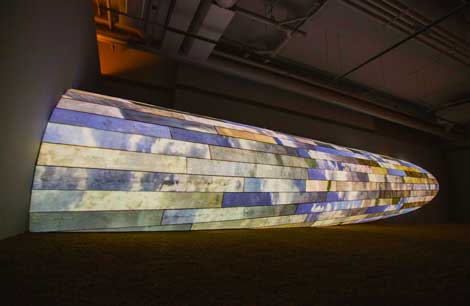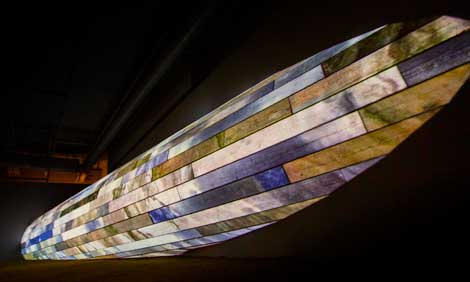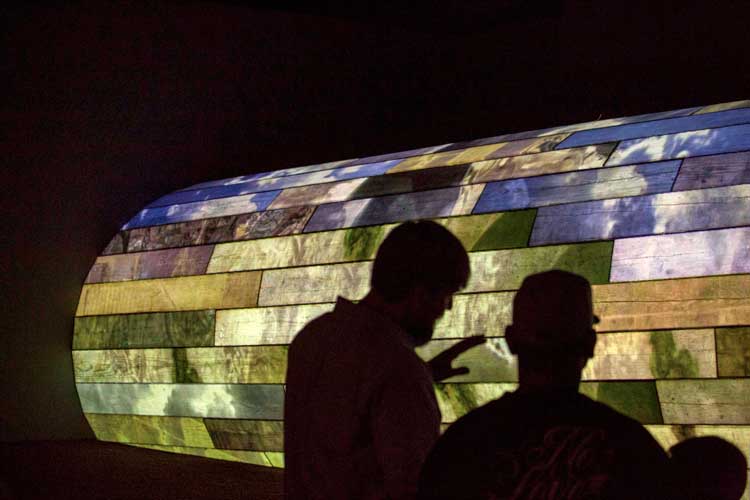As the Los Angeles Aqueduct celebrates its 100-year anniversary this month, many art institutions and organizations are showing support in their exhibition programming. Grand Central Art Center (GCAC) in downtown Santa Ana erected a monumental installation in commemoration of the centennial birthday.
Matt Moore & Braden King’s “Cumulus” from Creative Capital on Vimeo.
The Art Center invited artists Matthew Moore and Braden King to collaborate together on this abstract and environmentally inspired installation piece. The result is a massive installation that lives and breathes in the human experience, much like the Aqueduct itself. King and Moore chose to explore, examine and reflect upon the impact of the Los Angeles Aqueduct in a visceral experience inside the dark room of the center’s main gallery. The exhibition is part of a 16-institution initiative funded through the Metabolic Studio’s Chora Council Grants, in conjunction with the Aqueduct’s centennial.
The site-specific installation, titled “Cumulus,” is a culmination of a double residency that allowed for multiple site visits and time to talk and travel all across the length of the Aqueduct. The project is an attempt to tell the story of this 100-year old engineering marvel that was dedicated on Nov. 5, 1913, when thousands gathered northeast of Los Angeles to mark the opening. After Los Angeles used up all their own water sources, William Mulholland—the man in charge of the Los Angeles Department of Water and Power—started looking around for alternative sources. LA acquired land rights in the neighboring valleys, and built an efficient and gravity-powered transportation system for the Owens Valley’s water source. Without the water from the aqueduct, LA would not exist.

Cumulus (2013), Matthew Moore and Braden King. Image by Matthew Gush. Courtesy of Grand Central Art Center
Through the use of building materials, specifically old scaffolding planks, the artists have created a huge wooden pipeline that seamlessly emerges from one side of the gallery before quickly disappearing into the other—heading “underground,” even accompanied by dirt in the gallery space. Projected upon the water pipe are film clips of local atmosphere and landscape, moving and covering its wooden skin like water flows over river rocks. The atmosphere is a major part of this powerful piece—white noise of running water fill the pitch black gallery with nothing but the light of the mosaic-style projections on the giant wooden object to light up the view. The air is cold and the dirt fills the room with a scent of fresh earth, giving you a real sense of a re-imagined pipeline.
The artists’ collaboration seems intriguing and unique for both of these masterful yet entirely different professionals. The basic root of the irrigation and agricultural systems in modern society is of constant interest to Moore, who is a fourth generation farmer from the Phoenix, Arizona area, and much of his site-specific installation art touches on the inventions and presence of humans with our natural land. Moore’s fascination and connection with the land made him an easy pick for curator John Spiak, and the pairing of Moore with filmmaker King was a genius move. Involving digital aspects into this otherwise tangible installation finished the well-rounded experience in downtown Santa Ana. King has a cultural obsession in his art practice, and his creativity shines bright through this collaboration.

Cumulus (2013), Matthew Moore and Braden King. Image by Matthew Gush. Courtesy of Grand Central Art Center
The title of the piece serves as a hopeful reminder to visitors; cumulus clouds normally do not precipitate on their own, but can grow into cumulus congestus or cumulonimbus clouds, which produce the much-needed rainfall we live on. Moore places the title’s metaphorical weight on the cloud. “We can build all the infrastructure and systems to transport this precious resource, but if it doesn’t rain, they are all for naught.” He added, “There may be no more hopeful image than that of a cloud…the promise of sustenance and a future that cannot be controlled by the will of man.”


